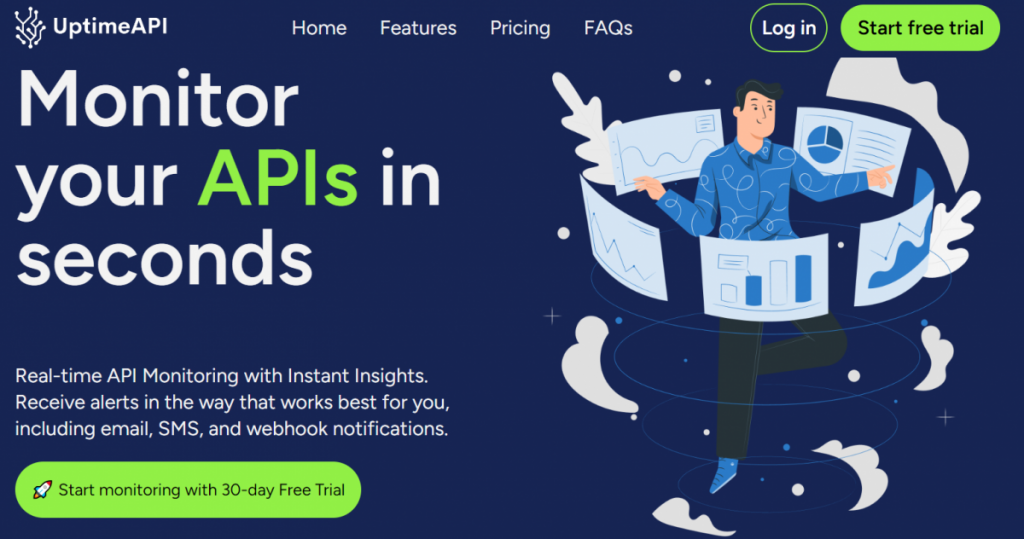In the realm of software development, robust and reliable APIs are the backbone of seamless interactions between applications. Ensuring the quality and functionality of these APIs is a critical aspect of the development process. This quick guide aims to provide developers with essential insights into API testing, accompanied by the powerful monitoring capabilities of UptimeAPI, a tool designed to streamline the testing and monitoring of API endpoints.
Understanding API Testing

1. What is API Testing?
API testing is a process that validates the functionality, performance, and security of an application programming interface (API). It involves sending requests to the API, examining the responses, and verifying that the API behaves as expected. API testing is crucial for detecting bugs, ensuring correct integration, and maintaining the overall reliability of software systems.
2. Why is API Testing Important?
- Early Bug Detection: APIs testing helps identify issues early in the development cycle, reducing the cost and effort required for later-stage bug fixes.
- Integration Assurance: It ensures that different components of the software, often developed by different teams, work seamlessly when integrated.
- Performance Optimization: APIs testing helps in identifying performance bottlenecks, ensuring that the API meets response time and throughput expectations.
- Security Validation: Security vulnerabilities can be uncovered through thorough APIs testing, providing an opportunity to address potential risks.
Types of API Testing

Read More: Company profile APIUsage Cases
1. Unit Testing
Unit testing focuses on testing individual units or components of an API in isolation. It ensures that each unit functions as intended.
2. Integration Testing
Integration testing involves testing interactions between different components or modules of an API to ensure they work together cohesively.
3. Functional Testing
Functional testing verifies that the API’s functions and features operate correctly according to specifications.
4. Performance Testing
Performance testing assesses the responsiveness, speed, and scalability of the API under various conditions.
UptimeAPI: Elevating API Testing with Monitoring
UptimeAPI extends the capabilities of APIs testing by providing real-time monitoring for API endpoints. This monitoring tool is particularly useful during and after the testing phase, offering developers insights into the live performance and availability of their APIs.
API Responses with UptimeAPI
Understanding API responses is pivotal in APIs testing. UptimeAPI ensures developers receive clear and informative responses, providing insights into the status and performance of their monitored API endpoints.
1. Healthy Response
A healthy API response indicates that the monitored endpoint is operational and responsive. It typically includes a success status code, such as 200 OK.
{
“status”: “success”,
“message”: “API endpoint is reachable.”,
“timestamp”: “2024-01-17T12:00:00Z”
}
2. Failed Response
A failed API response indicates that the monitored endpoint is experiencing issues or is currently unreachable. It is accompanied by a status code outside the 2xx range.
{
“status”: “failed”,
“message”: “API endpoint is not reachable.”,
“timestamp”: “2024-01-17T12:05:00Z”
}
3. Performance Metrics
UptimeAPI goes beyond binary responses by providing performance metrics. This includes information like response time, allowing developers to assess the responsiveness and speed of their APIs.
{
“status”: “success”,
“message”: “API endpoint is reachable.”,
“response_time”: 150, // Response time in milliseconds
“timestamp”: “2024-01-17T12:10:00Z”
}
Quick Guide to APIs Testing with UptimeAPI
1. Sign Up for UptimeAPI Account
Start by signing up for an account on the UptimeAPI website. Once registered, you gain access to the UptimeAPI dashboard.
2. Add API Endpoints
In the dashboard, add the API endpoints you want to monitor. Specify the endpoint URLs and any additional parameters required for monitoring.
3. Set Up Monitoring Preferences
Customize monitoring preferences to receive real-time alerts for downtime or performance issues. Define conditions that trigger alerts, such as response time thresholds or consecutive failures.
4. Integrate UptimeAPI into Testing Workflow
UptimeAPI seamlessly integrates with various testing frameworks. Follow the provided documentation for your preferred programming language or testing tool to incorporate UptimeAPI into your testing workflow.
Best Practices for APIs Testing with UptimeAPI
1. Combine Testing and Monitoring Efforts
Integrate UptimeAPI monitoring into your testing processes to gain real-time insights into the live performance of your APIs during testing scenarios.
2. Set Realistic Performance Benchmarks
Leverage UptimeAPI’s performance metrics to set realistic benchmarks for your API’s response time and throughput, ensuring optimal performance.
3. Continuous Monitoring
Use UptimeAPI’s continuous monitoring to identify and address issues as soon as they arise, enabling proactive responses to potential problems.
Conclusion: Streamline Your APIs Testing with UptimeAPI
APIs testing is a crucial step in the development lifecycle, and UptimeAPI enhances this process by providing real-time monitoring capabilities. By incorporating UptimeAPI into your APIs testing workflow, you not only ensure the functionality and reliability of your APIs but also gain valuable insights into their live performance. Streamline your API testing efforts, elevate your development practices, and ensure the seamless operation of your APIs with UptimeAPI.

